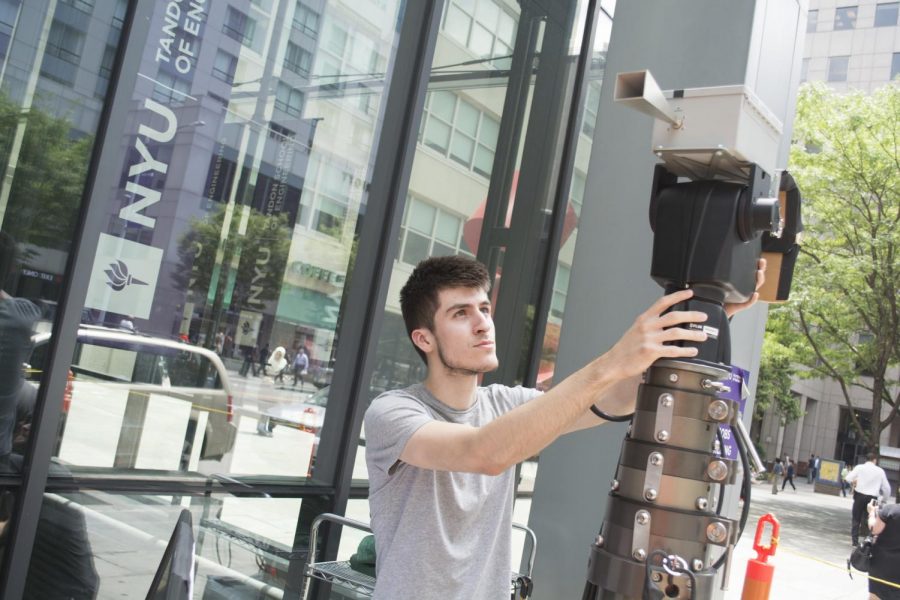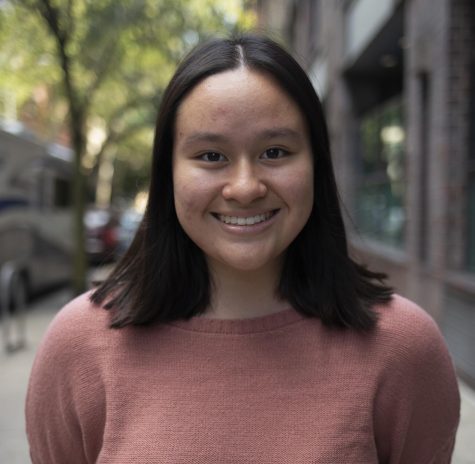Professors Work to Develop 5G Wireless Testbed
A student taking measurements of the way that millimeter waves travel and react in Downtown Brooklyn at Tandon.
April 23, 2018
Three Tandon School of Engineering professors will take part in research on the fifth generation of wireless network communications.
Sundeep Rangan, associate professor in the Electrical and Computer Engineering Department at the Tandon School of Engineering, heads the team. He is joined by Shivendra Panwar and Thanasis Korakis, a professor and research assistant professor, respectively, from the same department.
Cloud Enhanced Open Software-Defined Mobile Wireless Testbed for City-Scale Deployment, or COSMOS, is funded by a $100 million grant from the National Science Foundation’s Platforms for Advanced Wireless Research initiative, which designated Salt Lake City and New York City as the first two of four locations for its testbeds of the newest wireless networking technology. The New York City testbed will cover one square mile in West Harlem, funded by a $22.5 million cut of the grant.
The technologies tested could reduce the delay between movement and vision in virtual reality, improve safety in vehicles and even allow doctors to operate on patients remotely. They will also have a major impact on day-to-day activities.
“There’s kind of four components of it: the mobile, the base station, the private connection, then the cloud,” Rangan said. “The testbed physically is a number of base stations, so those are the antennas essentially and the processing nodes that the mobile phones would connect to.”
The main goal of the COSMOS testbed is to achieve ultra-high bandwidth and low latency on a large scale. Raising the bandwidth limits would increase the amount of data that can be sent in a fixed time, allowing users to download and stream content and use Internet-based applications at higher speeds. Lower latency would reduce delays in processing data, producing a similar effect.
Some cell service providers have begun to offer 5G wireless network technology in select cities, but it is still unavailable to most of the country. Technologies tested in COSMOS would make significant headway in increasing availability on a larger scale.
Professors from the engineering schools of Columbia University and Rutgers University will also work on the testbed, which has partnered with the city, IBM, the City College of New York, University of Arizona and Silicon Harlem, a community broadband provider.
The technologies at the heart of the testbed are millimeter-wave radio bands, software-defined radios, edge cloud computing and advanced optical networking.
Millimeter-wave radio bands can offer between 10 and 100 times the data rate currently available on most 4G cell phones but are not widely used in cellular networks.
“The millimeter waves were not used a lot because the feeling was that it has very poor propagation characteristics, so it would not penetrate, say, the brick of a building,” Panwar said. “But one of the professors here, Professor [Theodore] Rappaport at NYU, showed that in fact you could get a range of about 100 meters or 300 feet or maybe a little bit more [and] it can bounce off buildings [which] allows it to go around corners. That was kind of a revelation.”
Meanwhile, software-defined radios provide an advantage other than speed: access to the testbed regardless of location.
“Software-defined radios are very good for experimenters in the space,” Rangan said. “We’re trying to build a network where people can experiment with new ideas.”
The team is also hoping to look into edge cloud computing, which would serve as a physically closer and thus faster alternative to traditional cloud computing.
Finally, advanced optical networking would capitalize upon fiber optic technology to power faster connections between cell sites, such as cell towers, and cloud computing.
“Edge cloud is when you move that computation close to you,” Panwar said. “So maybe some small data center in your neighborhood, maybe just no more than 100 miles and probably no less than 10 miles away from you.”
The first platform of the technologies is slated for release in late 2019 or early 2020.
According to Panwar, it will include three sets of nodes — points that receive, store or distribute data in a network. Four base stations would serve as large nodes, nine smaller base stations would serve as medium nodes that could be placed on light poles or other fixtures and 20 small nodes could even move with students on their backpacks.
Clayton Banks, co-founder and CEO of Silicon Harlem, said the location of the testbed highlights the importance of serving areas with limited internet access.
“Deploying an advanced wireless network in Harlem will position the community to shape the future of connectivity,” Banks said in an email to WSN. “We envision the COSMOS project to deliver on our goal to provide affordable, fast and sustainable broadband to every resident in the country.”
The research comes at a time of increasing dependence on the internet, with a projected 24 billion internet-connected devices expected to be installed worldwide by 2020, according to Business Insider.
“Really, almost every electronic device we have today could benefit from wireless connectivity,” Rangan said.
A version of this article appeared in the Monday, April 23 print edition. Email Sarah Jackson at [email protected].




























































































































































